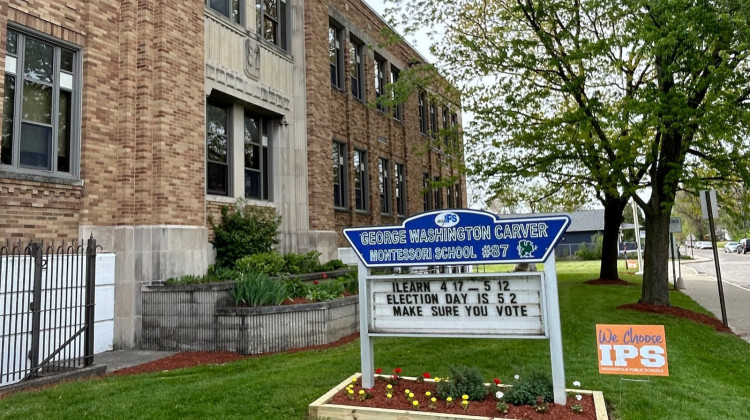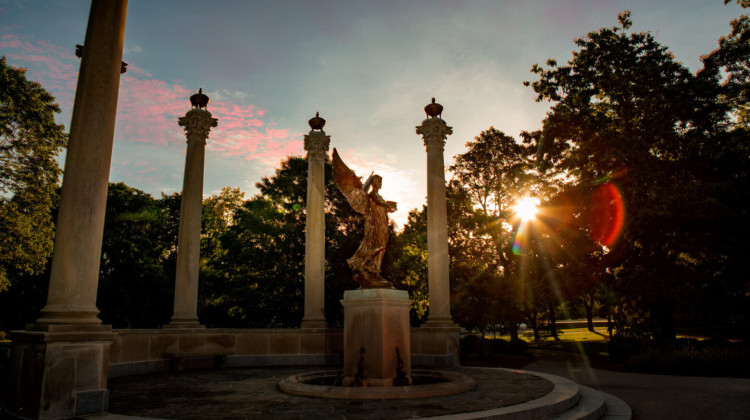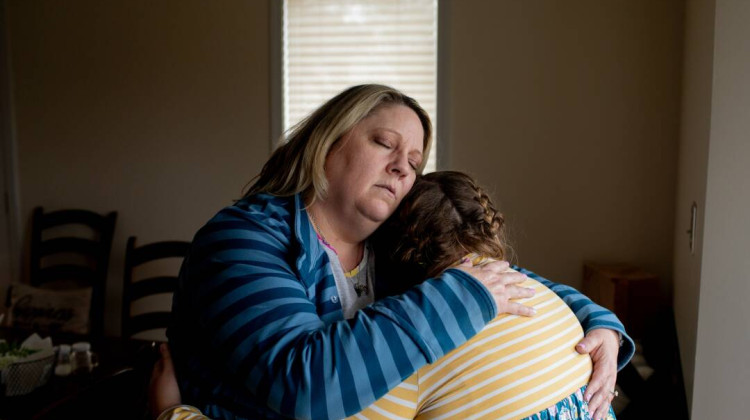
in 2018, half of Indiana students didn’t have a librarian at their schools, according to a report from the Indiana Library Federation.
Becca Costello/WFIU/WTIUEarly reading is important to student success – but Indiana’s young readers are struggling. The latest state test scores show 1 in 5 Indiana third graders lacked strong vocabularies and phonics.
State education leaders responded by announcing a $111 million investment in boosting student literacy rates. That includes state and philanthropic funds for instructional coaching for teachers on the science of reading, and the creation of a literacy center at the Indiana Department of Education, among other supports. But not all educators felt they were included in the initiative.
“There are no librarians mentioned in the plan, and several of the school librarians that I know that have reached out to ask to be part of this DOE literacy center that’s being created have not heard anything back,” said Emily Wilt, a librarian at Chesterton High School in Chesterton, Indiana, and the chair of the Association of Indiana School Librarian Educators. “So that’s kind of disappointing.”
A spokeswoman for the Department of Education did not directly address if librarians were involved in developing the literacy initiative, but said media specialists “will play a key role” in how the state rolls out its plan, which will “bring all stakeholders to the table to help students master foundational reading skills.”
“It’s important that we continue to lean-in and work together to urgently find solutions for our students,” IDOE spokeswoman Holly Lawson said in an email. “We look forward to continuing to work with our families, our communities, and our educators, including media specialists, as part of this vital work.”
Wilt and Pike High School librarian Chad Heck spoke with WFYI Digital Editor for Health and Education Lauren Bavis in a Twitter Spaces conversation Sept. 29. They discussed what librarians and other teachers can do to get kids interested in reading and literacy rates in Indiana back on track.
What is a librarian’s role in preparing students to read?
A 2007 study found that students in schools with better staffed and funded library programs performed better on state reading tests. But in 2018, half of Indiana students didn’t have a librarian at their schools, according to a report from the Indiana Library Federation.
“I think that having a certified librarian [in all schools] would increase our impact on student literacy,” Heck said.
A librarian’s work varies day to day, he continued. While thinking of a school librarian might bring to mind someone checking out books, Heck and Hilt said their jobs are more focused on working directly with students.
Another aspect of a librarian’s job is making sure the materials in the library are what students want and need to read.
“I think that’s a key part of literacy, is that students should have choice in what they read,” Heck said, “and the library’s always a place to give students that opportunity.”
Staffing is a challenge in schools – are teachers prepared to focus on literacy?
Schools across Indiana are having trouble filling teaching and support staff roles. Soon, some teachers will also have to add learning and teaching the science of reading – research-backed strategies to teach students to read.
“Adding another initiative to a lot of teacher’s plates – it’s a lot,” Hilt said. “They're feeling the pressure.”
It’s some teachers’ jobs to teach reading skills, and they are prepared, Hilt continued. And librarians like Heck and Wilt are ready and willing to help in the classroom. They are also certified teachers and experts at co-teaching, Heck said.
“We can go in and help those teachers who may not feel prepared to engage students in literacy and use our co-teaching powers to help push student growth,” he said.
When librarians have support staff, Hilt said they can also create reading engaging incentive programs. She created a library “escape room” – they can’t really look students in, but the students work in teams to solve puzzles and complete challenges that incorporate reading and workplace readiness skills.
But not every Hoosier student has that learning opportunity.
“Other librarians in my area that I meet with on a regular basis are not able to provide all of those things to their students because they might be the only certified person in their district,” Hilt said. “We’re all only human and we can only do so much. The more librarians and library staff that we have in our schools, the better our students will be.”
How do we get students interested in reading?
Reading is “a fun and essential part of life,” Hilt said. But she works with high school students, and “as they get older, they have less and less time” to read, she said.
While state test scores show student literacy is declining, Heck said book circulation in his library is at its highest in the 15 years he's been a librarian. Right now, he sees more students interested in manga and graphic novels, like “Heartstopper,” by Alice Oseman, which was adapted into a recent Netflix series.
“They’re just an easy way to introduce students to the love of reading,” Heck said.
Hilt has had a hard time keeping Holly Jackson’s “A Good Girl's Guide to Murder” on shelves. The series is about a high school student who tries to solve a cold case by starting a true crime podcast.
While efforts to crack down on the materials students have access to in libraries failed during Indiana’s last legislative session, at least 18 books were banned at public school districts in the last school year, according to free speech group PEN America. More than 1,600 book titles were banned across the county.
“I think sometimes book bans and challenges have the opposite effect,” Hilt said, laughing. “My high schoolers, when they find out a book has been banned or challenged somewhere, they want to know why and they want to know what’s in the book and they are clamoring for it.”
Hilt said creating lifelong readers starts with giving students the choice of what to read.
“If you are not able to find or access or read books that speak to you or you enjoy, then you’re not going to enjoy reading,” she said. “It’s just going to be a slog and you’re not going to choose to do that in your free time.”
Listen to the full conversation on Twitter Spaces.
Contact digital editor Lauren Bavis at lbavis@wfyi.org. Follow on Twitter: @lauren_bavis.
 DONATE
DONATE






 Support WFYI. We can't do it without you.
Support WFYI. We can't do it without you.